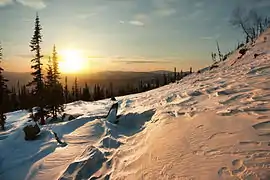Siberia (continent)
Siberia, also known as Angaraland (or simply Angara) and Angarida,[1] is an ancient craton in the heart of Siberia. Today forming the Central Siberian Plateau, it was an independent continent before the Permian period. The Verkhoyansk Sea, a passive continental margin, was fringing the Siberian Craton to the east in what is now the East Siberian Lowland.[2]

Angaraland was named in the 1880s by Austrian geologist Eduard Suess who erroneously believed that in the Paleozoic there were two large continents in the Northern Hemisphere: "Atlantis", North America connected to Europe by a peninsula (=Greenland and Iceland); and "Angara-land", eastern Asia, named after the Angara River in Siberia.[3]
Precambrian history
About 2.5 billion years ago (Siderian), Siberia was part of a continent of Arctica, along with the Canadian Shield. Around 1.1 billion years ago (Stenian), Siberia became part of the supercontinent of Rodinia, a state of affairs which lasted until the Cryogenian about 750 million years ago when it broke up, and Siberia became part of the landmass of Protolaurasia. During the Ediacaran Period around 600 million years ago, Protolaurasia became part of the southern supercontinent of Pannotia but around 550 million years ago, both Pannotia and Protolaurasia split up to become the continents of Laurentia, Baltica and Siberia.
Paleozoic history
Siberia was an independent continent through the lower Paleozoic until, during the Carboniferous Period, it collided with the minor continent of Kazakhstania. A subsequent collision with Baltica during the Permian completed the formation of the supercontinent Pangaea. The Siberian Traps formed.
Mesozoic and Cenozoic history
Pangaea split up during the Jurassic though Siberia stayed with Laurasia. Laurasia gradually split up during the Cretaceous with Siberia remaining part of present-day northeastern Eurasia. Today, Siberia forms part of the landmass of Afro-Eurasia. To the east it is joined to the North American Plate at the Chersky Range. In around 250 million years from now Siberia may be in the subtropical region and part of the new supercontinent of Pangaea Ultima.
Features
- Aldan Shield
- Anabar Shield
- Daldyn Terrane
- Magan Terrane
- Olenyok Uplift
- Tungus Terrane
See also
 Geology portal
Geology portal Siberia portal
Siberia portal
References
- Klets, A. G.; Budnikov, I. V.; Kutygin, R. V.; Biakov, A. S.; Grinenko, V. S. (2006). "The Permian of the Verkhoyansk–Okhotsk region, NE Russia". Journal of Asian Earth Sciences. 26 (3): 258–268. doi:10.1016/j.jseaes.2005.10.001.
- Permian bivalve mollusks of Northeast Asia, Fig. 1
- Sprague de Camp, L. (1970). Lost Continents: The Atlantis Theme in History, Science, and Literature. Courier Corporation. ISBN 9780486226682. Retrieved 25 October 2015.
External links
- Blakey, R. "Global Earth History: Sedimentation, Tectonics, and Paleogeography of Asia". Northern Arizona University. Retrieved 25 October 2015. (History of Siberia as well as other parts of Asia)
.svg.png.webp)
.svg.png.webp)
.svg.png.webp)
.svg.png.webp)


.svg.png.webp)
_political.svg.png.webp)
.svg.png.webp)
.svg.png.webp)
.svg.png.webp)